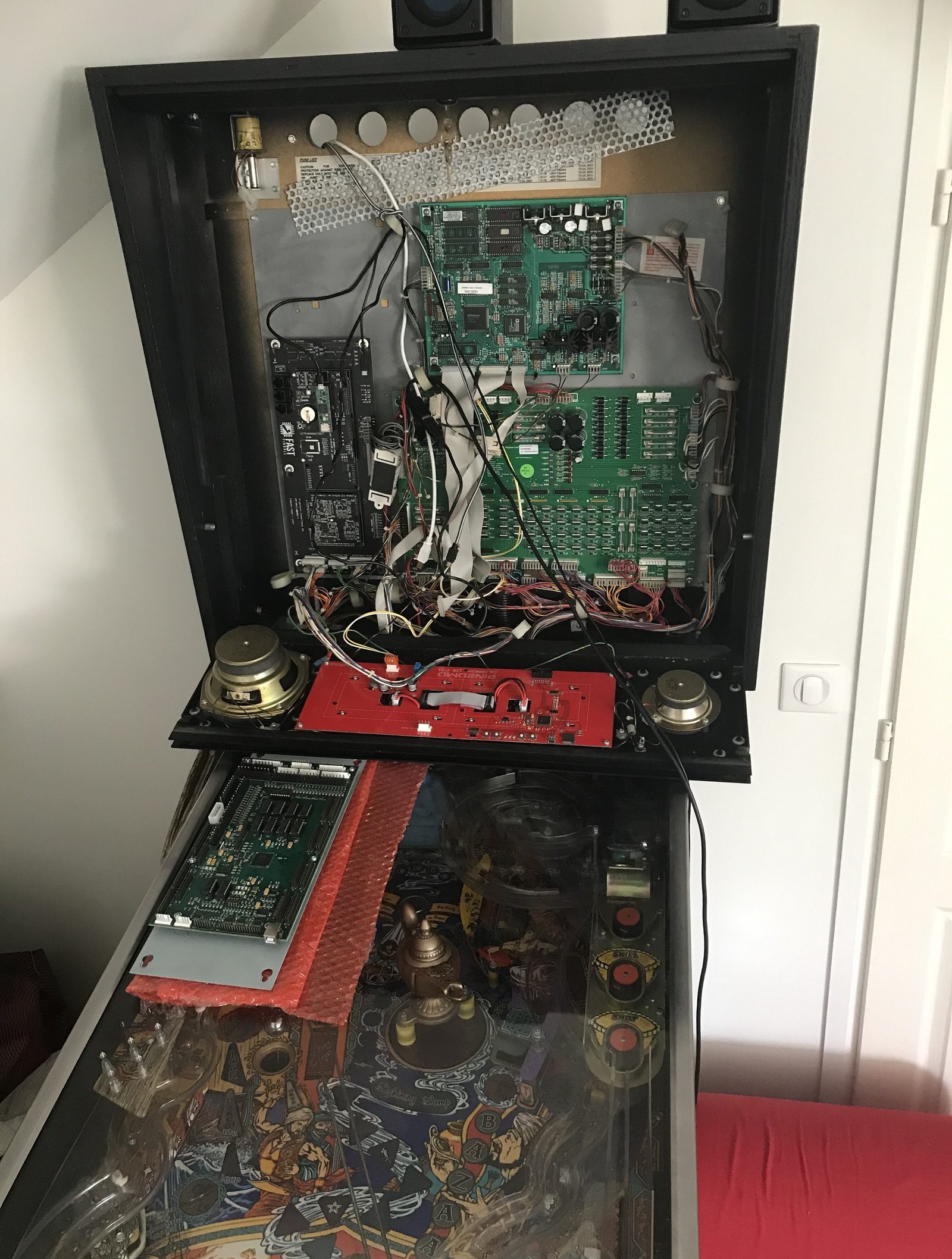If you follow the world of pinball customization and especially retro models, you can’t have missed the famous 2.0 conversion kits of some of the most popular titles.
Unlike Chicago Gaming Company’s Remake editions, which are remakes of old titles built with current technology (even if a majority of parts remain identical to the original model), here, we’re talking about hardware and software upgrades that allow old machines to get a nice facelift!
New code, colored screen, new board elements, art blades, sound card…each manufacturer has its own little accessory pack to embellish a new version of a title that sometimes has aged well.
This is notably the case of the Bride Of Pinbot 2.0 kit released by Dutch Pinball in 2014 or more recently, the Rudy’s Nightmare kit for FunHouse, created by Pedretti Gaming.



Good news! The trend continues with the announcement a few days ago by Mirco of the release of a 2.0 kit for the cult Tales Of The Arabian Night (TOTAN) by Williams. And cock-a-doodle-doo! It’s a French guy who is in charge of this kit and guess what? We interviewed him for you.
By the time this article will be published, the kit should be just available for sale after its official announcement at the Texas Pinball Festival 2022.
Sommaire
- 1 First of all, can you introduce yourself?
- 2 How did you get into the pinball world?
- 3 How did this TOTAN 2.0 kit project come about?
- 4 Is this your first kit of this kind?
- 5 Why did you choose the TOTAN in particular?
- 6 How long did it take you to develop it?
- 7 What were the different stages of design?
- 8 Can you describe this kit precisely ?
- 9 Why this partnership with Mirco, who is known for its playfields and RAD CALS?
- 10 Is Mirco involved in the design or do they only deal with manufacturing and distribution?
- 11 What were the main difficulties encountered in the development of this kit?
- 12 How will we get it?
- 13 Is this a limited run?
- 14 Can you give us a price range?
- 15 Will it be plug and play or will there be some adaptations to do ?
- 16 Are you planning any updates to make it evolve?
- 17 Any other ideas for kits in the future?
- 18 Any other thing you want to share with the Pinballmag community?
First of all, can you introduce yourself?
My name is Benoit, I’m 43 years old and I’m from Paris. I’m part of the generation that knew the emergence of the first consoles, arcade terminals and of course pinball machines in bars.
I discovered pinball when I was a teenager in 10th grade, there was a Gottlieb Gladiator’s a ten minute walk from the High School. I used to go there every day to play with my friends, it’s really a great memory. I kept this attraction for games and I always dreamed of having one at home.
How did you get into the pinball world?
In 2011, after having my triplets (yes!), I moved from an apartment to a house with a big garage. As a result, I quickly got the idea to buy a pinball machine. I immediately thought of a pinball machine more than an arcade machine because we already had the possibility to play a lot of titles on emulators, which was not the case with a pinball machine, for which I wanted to find the sensations of my adolescence.
How did this TOTAN 2.0 kit project come about?
The answer is quite simple: This is my first pinball machine, so I have a special bond with it. At the time, I had indeed looked at many models and for me it was by far the most beautiful, with the best music etc… Even if in the meantime I had more than fifteen models that turned.
But strangely enough, the TOTAN table did not stay with me very long. I quickly sold it because I found the gameplay too simple and not deep enough: Each game was mainly about turning the lamp, advancing the 7 stories without necessarily playing them… In short, you end up with the Wizard Mode in just 5 minutes of play if you are a good player.


I then went on with all the greatest Bally/Williams titles: Monster Bash, Medieval Madness, Cirqus Voltaire, Cactus Canyon, Attack From Mars etc… And after a few years, I found myself in a dilemma. I had had all the machines I wanted, but none of them had really seduced me or made me want to really spend time on them.
I needed something more consistent in terms of gameplay and that’s where this project was born.
I stumbled upon a project documented on Pinside (editor’s note: the biggest international forum dedicated to pinball), which was starting at the time. The project was to improve the code of the Bally Cactus Canyon pinball machine.
This initiative was started by an individual named Eric Preipke, who later worked with Spooky Pinball on Rick & Morty machine. The project was to rewrite the original program in a new language (Python) and add content to it.
This inspired me and so I started to rewrite the TOTAN code. Since the original ROM had a very limited memory and was extremely complicated to modify, I decided to completely rewrite the old code in a new language that offered more possibilities, the Python language.
The idea was especially to rewrite the TOTAN rules which, for me, were not really up to the level of the ambitions of this machine.
So I bought a TOTAN (obviously, it cost me 3 times more than the first one I had bought, 7 years before) and I started my own conversion project.
Is this your first kit of this kind?
Yes, it is. It’s a tribute to my first pinball machine.
Why did you choose the TOTAN in particular?
As I said, for me the TOTAN code doesn’t really live up to its design and the world it represents. It’s a pinball game that is easy to access for beginners but very quickly tiresome in the long run. From my point of view, it should have a more elaborate code, with more challenge. I’m a fan of the Bally/Williams machines from the 90’s and I really wanted to improve this machine!
How long did it take you to develop it?
Between 4 and 5 years, with very intense periods and others where I didn’t really touch the project. After that, you have to know that a project like this one is several hundreds, even thousands of hours, and I’m not even exaggerating!
What were the different stages of design?
We had to get the original assets. Since they were not directly accessible, I had to use emulation for that.
Then, I had to rework the frames almost one by one to recreate each animation, sometimes correcting a few mistakes, all pixel-perfect.


After that, I had to recover the basic development platform that was shared by a partner of Multimorphic (editor’s note: the manufacturer of the P3 hybrid machine). They created a new board to replace the original CPU board to allow it to understand the new language (Python) that I was going to use in my new code.
And then I finally got the original music back, which is easily found.
I just had to start! 🙂
Can you describe this kit precisely ?
On the code side, we have a lot of new modes, improved gameplay, new music…
On the gameplay side, there will be 14 stories to finish (instead of 7 in the original version), special and original modes, video modes that didn’t exist in the original version and other surprises 🙂
On the design side, there is a new speaker panel, a color screen, new speakers with RGB leds, new instruction cards and an automatic ball launcher to install (not present in the original model, probably for cost reduction reasons).


It is important to note that I wanted to stay 100% faithful to the code and spirit of the original pinball machine. I spent a lot of time identifying and recreating all the lighting effects as well as all the mechanics that drive the coils, the magnets etc…
The expansion with its new modes was created with relatively simple animations, effects and rules, in the same spirit as the original Tales of the Arabian Nights pinball machine.
The player is for example guided by light effects, a sound or a reminder on the screen to know where to send the ball. Special light sequences occur at the end of a sequence, a jackpot, etc…
Why this partnership with Mirco, who is known for its playfields and RAD CALS?
An associate who manages a platform for new projects and homebrews put us in touch. Mirco has an industrial power and official licenses, things that I did not have. That’s all.
Is Mirco involved in the design or do they only deal with manufacturing and distribution?
Let’s say I have 99% of the rights to my code. I had to make one or two changes, but they were pretty minor, so it wasn’t a big deal.
What were the main difficulties encountered in the development of this kit?


First of all, it should be said that there have been many similar projects initiated, for Attack From Mars, Medieval Madness, Judge Dredd and other models, but most of them have never been completed. The reason is quite simple: The time commitment is enormous and the problems encountered are quickly discouraging.
You really have to be passionate about it and have a strong will. I already started with the desire to modify the last version of the code provided by Williams for the TOTAN (the 1.4). It took me almost 2 years. That’s when I started my thread on Pinside because I knew I would get to the end of the project.
For the animations, I won’t go into details but getting them all was a huge challenge. I had to go through emulation with live gameplay sessions, capture them and rework them completely. It was clearly not the most interesting part of the project.
For the design, I was lucky to be able to join a private development network where I found help when I needed it. Nevertheless, you have to rely a lot on yourself because information, when it is available, is quite hard to find.
How will we get it?
After the announcement of the Texas Pinball Festival 2022, on the official website of Mirco (based in Germany).
Is this a limited run?
We had planned for 50 kits at the beginning. We are limited on some parts because of the problems of supply of components that come from China.
There are already some people interested following the teaser of Mirco a few weeks ago, so it’s a good sign.
Can you give us a price range?
The price of a topper! 🙂
About 2000 euros (Editor’s note – Update on 03/28/2022: the kit has just been put online at 2,700€, or about $3,000 excluding shipping and custom fees) for all the elements of the kit, it’s globally the same order of price as for a Funhouse V2 kit.
Will it be plug and play or will there be some adaptations to do ?
More like plug and play. The installation will take about an hour.


Are you planning any updates to make it evolve?
Yes, of course, especially for mechanics where the behavior can potentially vary. I’m 100% behind my project and it’s not about to stop!
Any other ideas for kits in the future?
Yes, I have Medieval Madness or Cirqus Voltaire games in mind. After that, there has to be a real need for these models. The original code is already very good, so we’ll see.
I have a thread on pinside with the evolution of my project over time… You can see that the screen support, which was originally for Dot Matrix, has migrated to LCD and then RGB Led from PIN2DMD, as well as that provided by “mypinballs”.
The supported cards are P-ROC and FAST, so I’m multi hardware.
And finally, I managed to connect my project via Visual Pinball to be able to test my code in virtual. It helped me at the beginning to test the light effects, even if the goal was always to produce it for a real pinball machine.
A big thank you to Benoit for sharing these elements with us exclusively for Pinball Mag. A huge congratulations from the whole community for having completed his project.We will be sure to let you know about his future progress and possible next projects!

